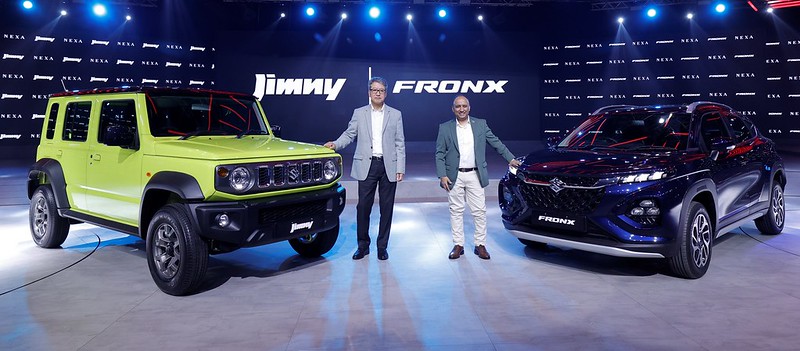Maruti Suzuki has come a long way not only in terms of automobiles but also in its creative journey. With some iconic campaigns like ‘Kitna deti hai’ and ‘Petrol Khatam Hi Ni Hunda’, both from Publicis Capital, the brand’s storytelling has always had a strong focus on the value proposition. While that legacy doesn’t change, the brand is looking at adding more aspirational value to the narrative. The ‘#TrueStories’ spot by MullenLowe Lintas Group for the newly launched Jimny is a step in that direction.
Shashank Srivastava, senior executive director at Maruti Suzuki India says the brand would be coming up with a lot of user generated content, influencer driven content and content putting women behind the wheel.
Why the change though?
“Retail experience of consumers has changed and so have their expectations. Any company, especially market leaders like Maruti Suzuki, if they have to maintain leadership, they have to change as the consumer, consumerism and consumer behavior changes. We have always made consumers the center of all our choices. So, whether it is the choice of products, technology or the choice of network and communication, everything is in response to what the consumer wants,” says Srivastava.
By changing expectations Srivastava means the aspirational millennial and Gen Z consumer who look for a lot more than value propositions and fuel efficiency in the vehicles they drive.
“If you look at our past communications be it ‘Kitna Deti Hain’ or the ‘Petrol Khatam Hi Ni Hunda’ or even the ‘Kancha’ ad where we showed how Maruti Service Stations existed even in the farthest places we were communicating with the audience that were looking for fuel efficiency, price value and peace of mind. Those are things which are still very important by the way, and we still continue to give that message, but the tone and tenor of the new campaigns have become sharper, younger and edgier for the new aspirational buyer,” Srivastava says.
Enter the Jimny campaign.
The Jimny story
The new spot from Maruti Suzuki that is inspired by true stories was a spot carefully designed by the creative agency. While the ad is the first of many that will focus on the brand’s SUV offerings, Jimny was special because of its legacy.
“The story in the spot is not the director’s imagination. We thought of the legacy of the vehicle and collected stories from across the world where Jimny made its way through extreme terrains and climatic conditions and finalized on three of them,” says Srivastava.
The spot tells three stories. One from the time when Spain saw a snowstorm called Filomena where Jimny played a role in helping people get food and essentials. It also helped a mother and her new born get home. Then there’s the story of a couple who explored ten African countries and climbed five of the highest peaks, a jouney taken in a Jimny, covering 7000 km in 8 months. The third story is of how the Jimny helped scientists explore an inaccessible archaeological site in Spain known as ‘The Pit of Bones’.
“We had to marry the product’s authenticity, the purity of that function and marry it with legacy,” Srivastava says.
The next leg of the campaign for Jimny will replace the #TrueStories with #WhatsYourStory and build on real life experiences of Jimny owners in India.
What makes the Jimny story important is the company’s renewed focus on the SUV segment that according to Srivastava would be targeting the rough and tough off-roader who is an aspirational buyer and is looking for features, tech and functionality in their vehicle.

Focus on SUV
Srivastava shares some hard numbers on the popularity of SUV as a segment. According to him, SUVs were about 16 percent of the market in 2018 and they have now touched 40-43 percent of the overall market.
“Our non SUV market share is 65 percent plus, which is very high and it’s been growing in the last five years. Now, when you combine it with SUV, then our market share falls below 45 percent because our SUV market share is only about 14-15 percent. Clearly, if we want to achieve our medium term objective of 50 percent market share, we have to increase our share in the SUV space,” he says.
There are about SUV 46 models across sub categories in the market and Maruti owns just two of them – Brezza and Grand Vitara.
“We realize two models may not be sufficient in this large segment and we have to strengthen our portfolio if we want to achieve our 50 percent market share and become the number one in the segment by 2023-24,” Srivastava adds.
The launch of Jimny and Fronx and the company’s focus on marketing the two vehicles thus becomes a priority for Maruti Suzuki.
Focus on women consumers
With the percentage of women among car buyers growing consistently, most auto brands are looking at putting together more inclusive campaigns. Maruti Suzuki is no different.
20 years back, Srivastava says there were just about 2-3 percent women buyers in the country whereas the present number is close to 13 percent.
The market is only going to grow from here on, says Srivastava and Maruti Suzuki wants that to be a part of creative communications.
“Women are becoming more independent, both economically and otherwise. Even when women are not buyers they are always influencers. Our campaigns will reflect that,” Srivastava says.
Budget allocation and distribution
Explaining where the marketing monies go for Maruti Suzuki, Srivastava says, “There are four broad categories where we put in the maximum money. One is the launch of new products where we spend a sizable chunk of our money to establish a brand. Then there is investment in sustainability of the brand followed by corporate campaigns, which is not limited to one brand alone or one model alone, but the overall brand marketing and finally there is a selling budget or what we call a tactical budget.”
In 2022-2023 the company is expected to spend anywhere between Rs1000 crore and Rs1100 crore towards marketing expenses and the ballpark estimation for the next fiscal is close to Rs1200 crore where 30-35 percent would be allocated for digital followed by 20-31 percent for TV and the remainder in print, cinema, OOH and radio.
